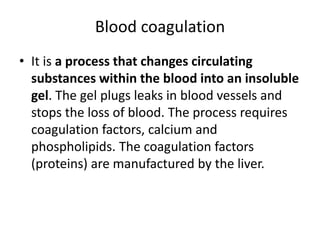
coagulation.pptx
- 1. Blood coagulation • It is a process that changes circulating substances within the blood into an insoluble gel. The gel plugs leaks in blood vessels and stops the loss of blood. The process requires coagulation factors, calcium and phospholipids. The coagulation factors (proteins) are manufactured by the liver.
- 2. Mechanism of Blood Coagulation • Basic Theory and General Mechanism • Clotting takes place in three essential steps: • (1) In response to rupture of the vessel or damage to the blood itself, a complex cascade of chemical reactions occurs in the blood involving more than a dozen blood coagulation factors. The net result is formation of a complex of activated substances collectively called prothrombin activator. • (2) The prothrombin activator catalyzes conversion of prothrombin into thrombin. • (3) The thrombin acts as an enzyme to convert fibrinogen into fibrin fibers that enmesh platelets, blood cells, and plasma to form the clot
- 3. • Conversion of Prothrombin to Thrombin •
- 4. • Pro-thrombin is a plasma protein, an alpha2-globulin, having a molecular weight of 68KDa. It is present in normal plasma in a concentration of about 15 mg/dl. It is an unstable protein that can split easily into smaller compounds, one of which is thrombin, which has a molecular weight of 33.7KDa almost exactly one half that of pro-thrombin. • Vitamin K: • Vitamin K occupies a central role in the relationship between the liver and the coagulation system since it is required for the synthesis of functionally active forms of a number of coagulation factors and inhibitors by the liver, including prothrombin, factor VII (FVII), FXI, FX, protein C, and protein S.
- 5. Conversion of Fibrinogen to Fibrin—Formation of the Clot • Fibrinogen is a high-molecular-weight protein (MW = 340KDa) that occurs in the plasma in quantities of 100 to 700 mg/dl. Fibrinogen is formed in the liver and liver diseases can decrease the concentration of circulating fibrinogen. • Blood Clot: A blood clot is a clump of blood that has changed from a liquid to a gel-like or semisolid state. • Clot Retraction—Serum Clot retraction is the "shrinking" of a blood clot over a number of days. The edges of the blood vessel wall at the point of injury are slowly brought together again to repair the damage that occurred.
- 6. Extrinsic Pathway for Initiating Clotting • Extrinsic Pathway • The extrinsic pathway is activated by external trauma that causes blood to escape from the vascular system. This pathway is quicker than the intrinsic pathway. It involves factor VII. • 1. Release of tissue factor. releases a thromboplastin composed of phospholipids plus a lipoprotein complex (a proteolytic enzyme). • 2. Activation of Factor X—role of Factor VII and tissue factor. • The lipoprotein complex with blood coagulation Factor VII and, calcium ions, acts enzymatically on Factor X to form activated Factor X (Xa). • 3. Effect of Xa to form prothrombin activator—role of Factor V • The activated Factor X combines with phospholipids as well as with Factor V to form the complex called prothrombin activator.
- 8. Intrinsic Pathway for Initiating Clotting • Intrinsic Pathway • The intrinsic pathway is activated by trauma inside the vascular system, and is activated by platelets, exposed endothelium, chemicals, or collagen. This pathway is slower than the extrinsic pathway, but more important. It involves factors XII, XI, IX, VIII. • 1. Blood trauma causes • (1) activation of Factor XII and (2), release of platelet phospholipids. • Trauma to the blood alters two important clotting factors: • Factor XII and the platelets. • It converts into a proteolytic enzyme called “activated Factor XII.” The platelet phospholipids that contain the lipoprotein called platelet factor 3, which also plays a role in subsequent clotting reactions.
- 9. • Activation of Factor XI. The activated Factor XII acts enzymatically on Factor XI to activate this factor. • It requires HMW (high-molecular weight) kininogen and is accelerated by prekallikrein. • 3. Activation of Factor IX by activated Factor XI. • The activated Factor XI then acts enzymatically on Factor IX to activate this factor as well. • 4. Activation of Factor X—role of Factor VIII. • The activated Factor IX, acting in concert with activated Factor VIII and with the platelet phospholipids and factor 3 from the traumatized platelets,
- 10. • 5. Action of activated Factor X to form pro-thrombin activator— role of Factor V. • This step in the intrinsic pathway is the same as the last step in the extrinsic pathway. • Role of Ca2+ in Intrinsic and Extrinsic Pathways • Calcium binds to the phospholipids that appear secondary to the platelet activation and provides a surface for assembly of various coagulation factors. • Initial receptor engagement stimulates Ca2+ spikes in the platelets that lead to firm, permanent adhesion between the vessel wall and the primary layer of platelets. Ca2+ ions signals in this bottom layer are propagated among cells to promote platelet aggregation.